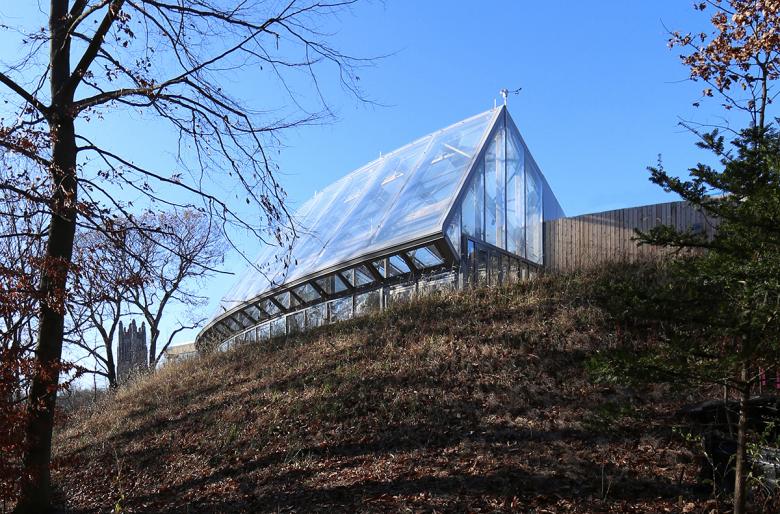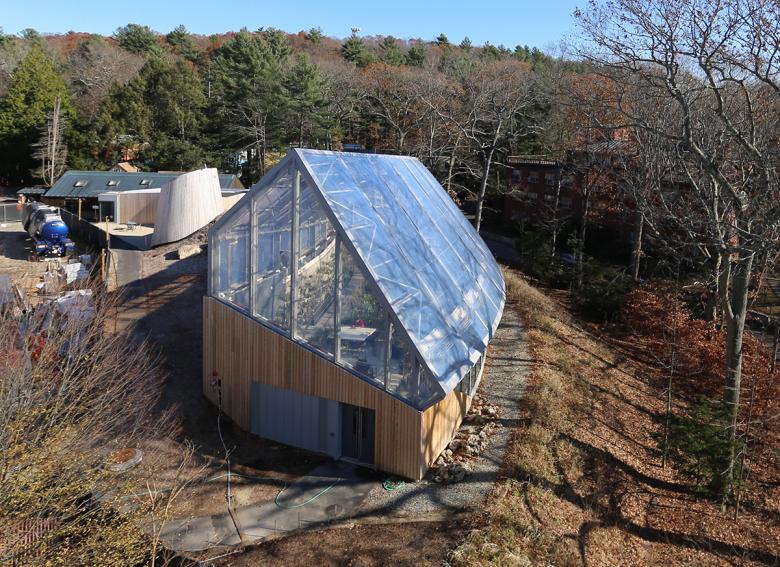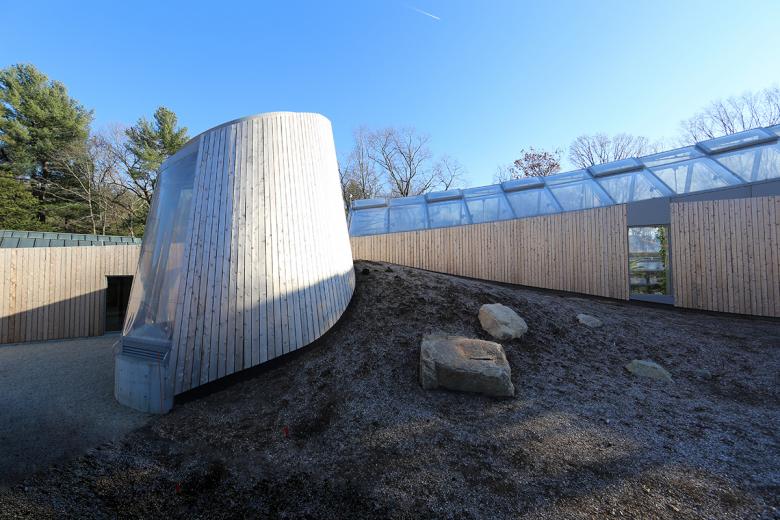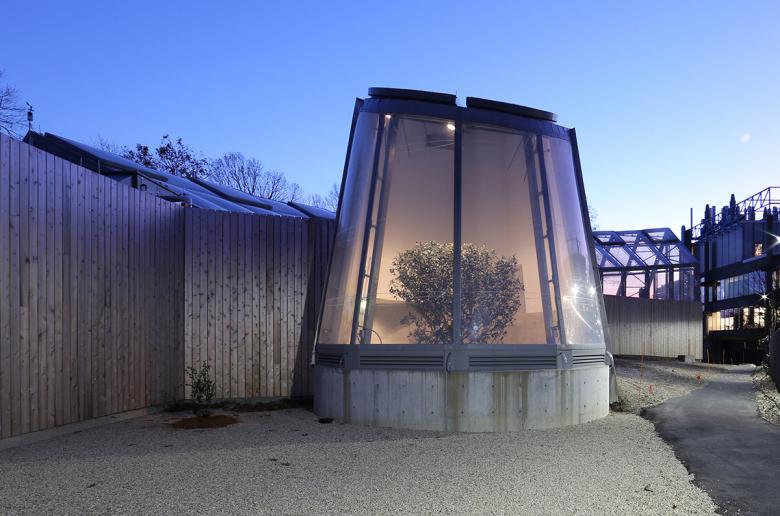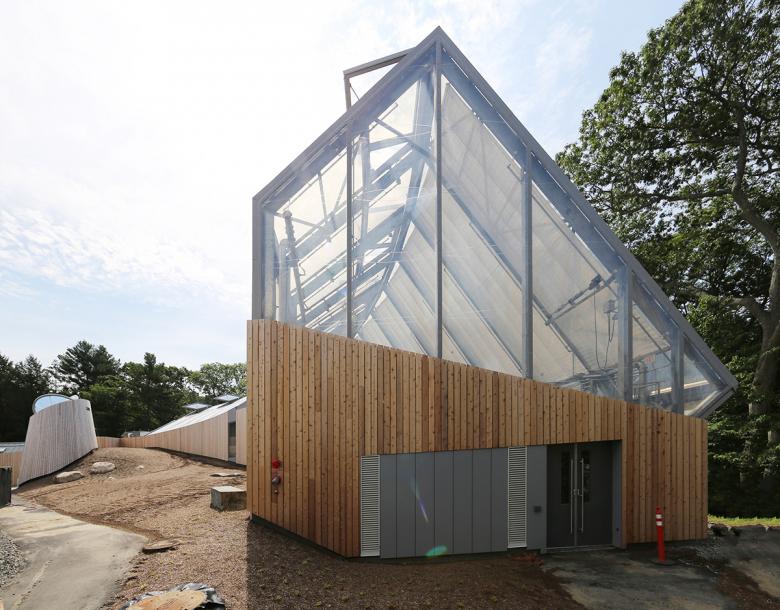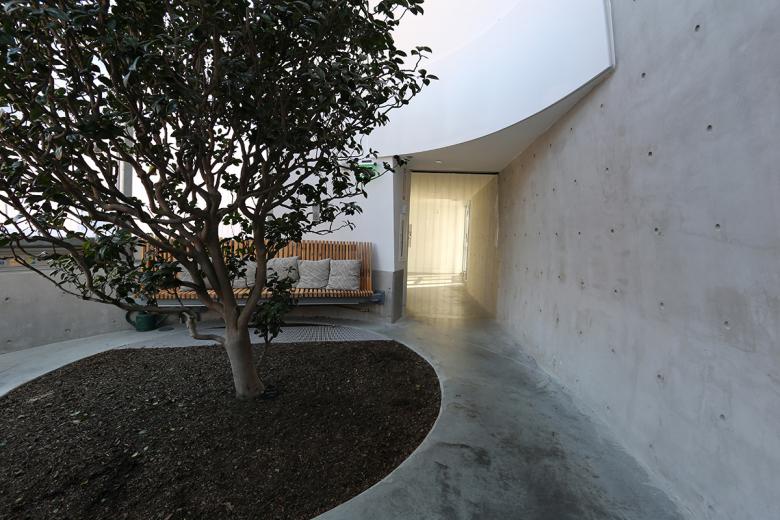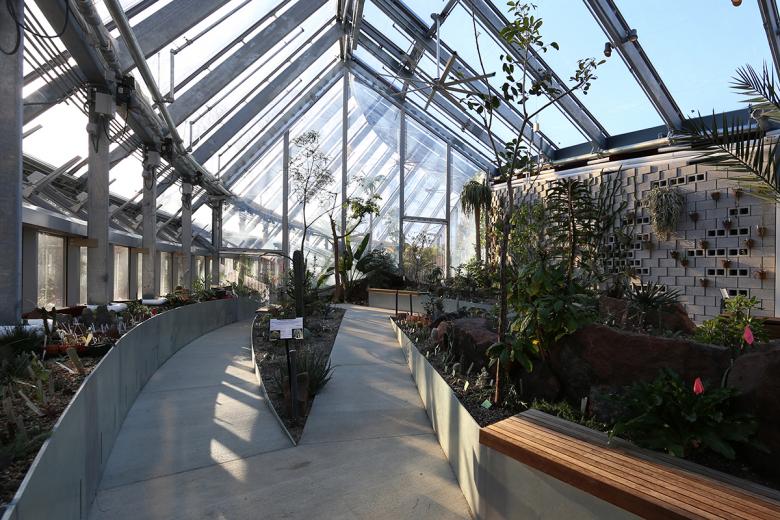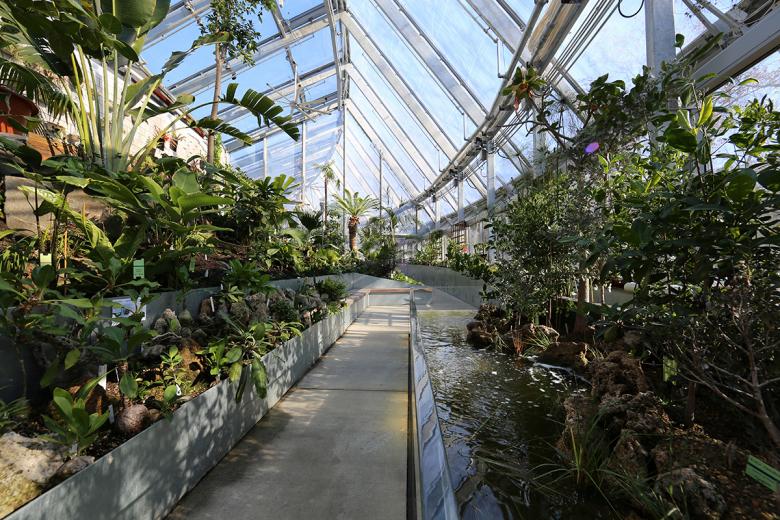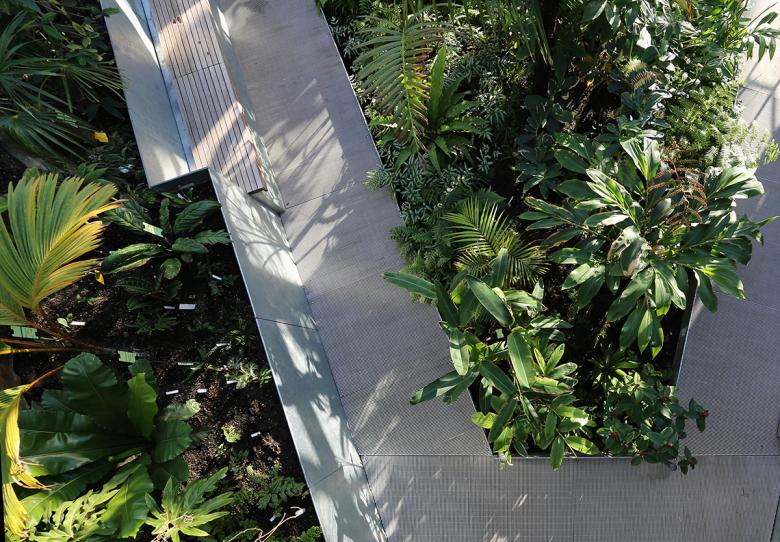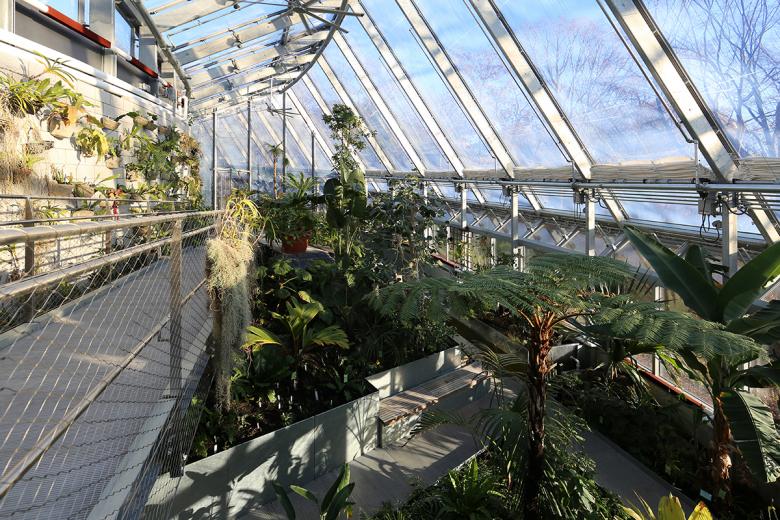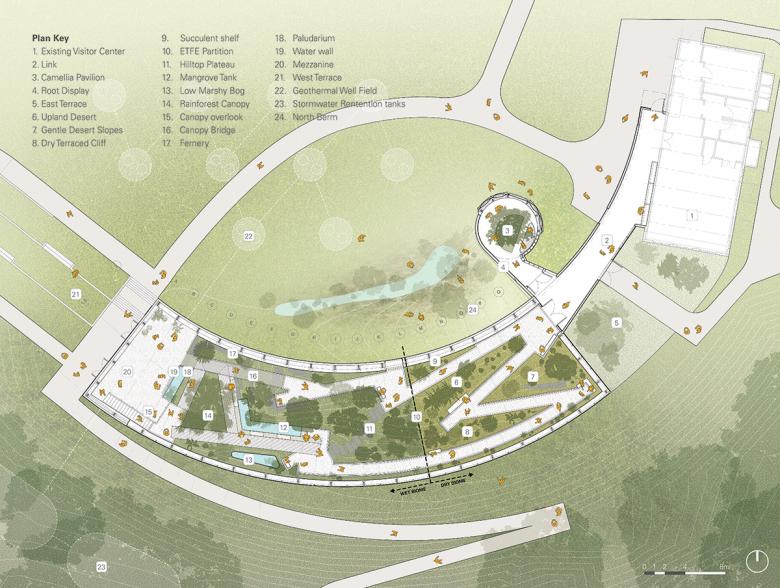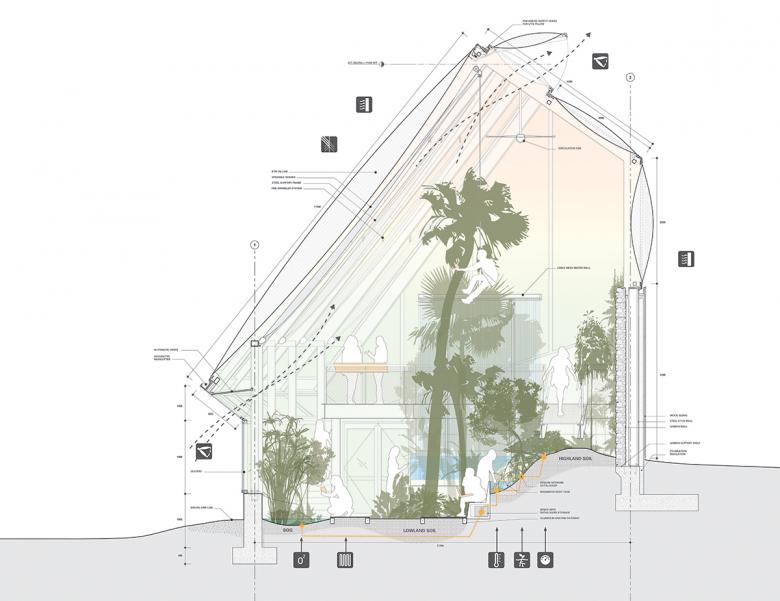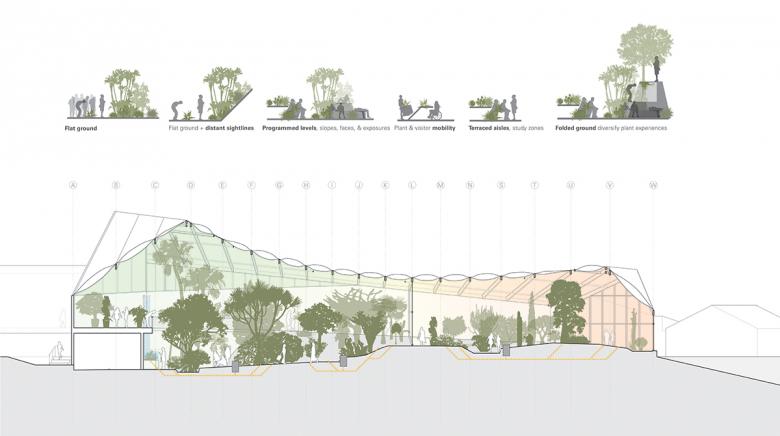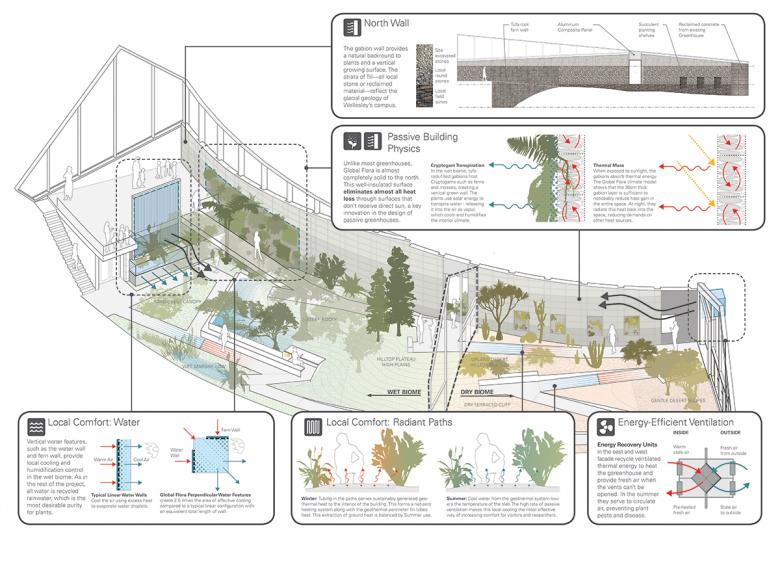U.S. Building of the Week
Global Flora
Kennedy & Violich Architecture
13. July 2020
Photo courtesy of KVA
World-Architects first learned about the greenhouse designed by Kennedy & Violich Architecture for Wellesley College in 2017, when it won a LafargeHolcim Award. The building was completed two years later, as part of a larger Science Center that will wrap up construction in spring 2022. The architects at KVA answered a few questions about Global Flora, the replacement of the century-old Margaret Ferguson Greenhouse.
Location: Wellesley, Massachusetts, USA
Client: Wellesley College
Architect: Kennedy & Violich Architecture
- Design Principal: Sheila Kennedy
- Project Architect: Juan Frano Violich
- Project Manager: Ben Widger
- Project Team: Alex Shelly, Shawna Meyer, Kyle Altman, Bob White, Nick Johnson, Daniel Sebaldt, Michael Bennet, Diana Tomova, Peteris Lazovski, Mark Bavoso, Lynced Torres
MEP/FP Engineer: Buro Happold
Landscape Architect: Andropogon
Lighting Designer: Suzan Tillotson
Climate Engineer: Transsolar
Civil Engineer: Judith Nitsch
Contractor: Turner Construction
ETFE: Foiltec
Steel: Canatal
Automated Greenhouse Control System: Argus
Building Area: 7,500 sf (700 sm)
Photo courtesy of KVA
What were the circumstances of receiving the commission for this project?The Global Flora Project was a response to an international Request for Qualifications (RFQ) issued by Wellesley College to select an architectural design lead for the replacement of the 100 year-old Margaret Ferguson Greenhouse Conservatory housing the college’s renowned collection of plants. The KVA Team was selected from a shortlist of international architects from the US and UK and work proceeded in the fall of 2015.
Photo courtesy of KVA
Please provide an overview of the project.The Global Flora botanical facility expands the 1920 vision of Dr. Margaret Ferguson, a professor and department head of the Department of Botany at Wellesley College. Ferguson argued for plant biology as a central part of science education and encouraged students to “listen to” plants and learn through hands-on interdisciplinary experiences.
Today, Global Flora houses a pre-eminent plant collection in dry and tropical biomes, some from the existing conservatory and many from collections across the US. One species in particular, the iconic Durant Camellia tree, over 140 years old, continues to occupy a central location in the facility, housed in a seasonal pavilion designed specifically for it that is connected with the new facility.
Photo courtesy of KVA
Global Flora exceeds the net-zero water requirements of the Living Building Challenge (LBC) and is engineered for net-zero energy when Wellesley converts to campus solar and geothermal systems. An open source interactive sensor platform allows people to gather and share real-time data from plants, soil, air, and water over multiple public digital media platforms. Gathered data is accessible to international research universities and public schools, thereby strengthening the global knowledge sharing platform.
The Global Flora reimagines how the design of a sustainable greenhouse can enhance global interdisciplinary science education and deepen a public understanding of nature. It is a free and public botany lab and “museum” that emphasizes the importance of environmental stewardship to current and future generations on-site and online.
Photo courtesy of KVA
What are the main ideas and inspirations influencing the design of the building?One of the driving forces behind the Global Flora is the concept of “giving voice to plants.” The Global Flora project takes the position that no lasting economic prosperity is possible without social equity and shared environmental action to address climate change. Human cultures are dependent upon Earth’s plant species, which are threatened by climate change. Global Flora is a living plant seed bank that supports the lives and health of many global populations. The social, cultural and environmental benefits of public education and scientific research of the Global Flora project are expanded by its sensor platform that is integrated into the building architecture, the living soils, water, and air-environment of the plant collections enabling people around the world, who could not otherwise do so, to access the plant collection in a very energy efficient and sustainable manner.
Photo courtesy of KVA
Another critical factor for the project was to advance the idea that the building could create a synergistic relationship with the plants, the path of the sun, and take advantage of its site on campus. Global Flora places emphasis on a “breathing building” envelop that responds to atmospheric changes in micro-climates. It reimagines the “stand alone” conservatory as an integrated set of wet and dry biomes that are heated and cooled using only renewable resources. The light, low carbon footprint of the greenhouse offers a transferable new model for contemporary sustainable construction. If net-zero human comfort can be achieved for tropical and desert environments in the cold and humid New England climate, it can be done anywhere. The curved form of Global Flora follows the east-west arc of the sun to maximize passive heat gain for the plants and demonstrates how design aesthetics integrated with net-zero building performance can improve the overall sustainability of a building’s larger context. Sited within a glacial topography that serves as a watershed for Lake Waban and adjacent to a complex of science buildings, the Global Flora produces 100% of its own water needs, creating a larger sustainable footprint than its one-hectare footprint would otherwise suggest. Water is filtered and stored within underground reservoirs for plant irrigation and building maintenance.
Photo courtesy of KVA
How does the design respond to the unique qualities of the site?Frederick Law Olmsted’s 1921 master plan for the Wellesley Campus was unique in its day. It resisted the conventional campus quadrangle approach to planning and instead worked with the site’s glacial topography by placing academic clusters on top of the multiple hills scattered throughout the campus. This was a conception of “design-in-section” rather than a top-down plan approach. One of these was Science Hill where the original Margaret Ferguson Greenhouse was sited and where the Global Flora project would follow. The site’s steep slope allows the building to engage with the topography resulting in a greenhouse that varies in height based on its position on site. As the site drops the interior volume of the greenhouse gets taller making room for the larger species of plants like palms.
The accommodation of different tree heights produces a dynamic and varying interior space which maximizes people’s experiences among the botanical collections supporting flexible public programs, from pop-up research labs to places for group study, reading, relaxation and musical performance. Design-in-section sets-up a different relationship between people and different plant forms. Transparency between the biomes through the use of a translucent Ethelyne Tetrafluoroethelyne (ETFE) partition enables the direct visual comparison of plant form between extreme climate biomes. Each biome helps to support the other’s needs through passive air and energy transfer; the design demonstrates ecological synergy and supports the comparative study of adaptive plant biology.
Photo courtesy of KVA
Was the project influenced by any trends in energy-conservation, construction, or design?The Global Flora Project is a singular synergistic ecology where architecture and nature work together through strategies of carbon reduction, the use of renewable resources, and an interactive climate management system. The project meets LBC certification for net-zero water and is net-zero energy-ready.
Global Flora meets LBC criteria performance through the radical integration of natural landscape topography, building form, plant biomes, and sustainable passive systems that minimize energy use. Site orientation maximizes exposure to sunlight, which passes through the ETFE envelope and is stored in a trombe wall, providing thermal mass. The ETFE envelope and steel structure are sourced regionally. Use of local wood from campus trees and regional rock forms used in the interior landscape minimize embodied energy in construction and reduces carbon emissions. Within wet and dry biomes, Global Flora is 100% passively cooled through natural ventilation and fans and passively heated by thermal energy from the sun and geothermal-ready radiant heating elements. Human comfort is provided by local cooling and heating zones that create microclimates to serve areas where people congregate particularly around water features such as a mangrove pool and paludarium. The design of active local microclimates eliminates the need for overall, even temperature conditioning in the spaces. These ensure a comfortable environment for both people and plants while greatly reducing energy needs, use, and carbon emissions.
Photo courtesy of KVA
Further energy-conservation features include:
- Energy-Efficient Ventilation – The Global Flora Project avoids the use of mechanical cooling through open vents, stratification fans, evaporative cooling, and heat-absorbing surfaces controlled by the Argus building climate management system.These vents are located along the structure’s ridge as well as along the building’s lower perimeter façade. With the addition of large bi-directional ceiling fans and the natural stack-effect of the greenhouse section, the Global Flora can exchange 100% of its interior air multiple times over the period of the day so that even in the hottest and most humid summer days plant and soil temperature remain stable. Dry and wet biome’s distinct ecology help to support one another’s needs through passive air and energy transfer at openings where they connect. In this way, the design demonstrates ecological synergies and supports the comparative study of adaptive plant biology.
- Energy Recovery Units in the east and west facade recycle ventilated thermal energy to heat the greenhouse and provide fresh air when the vents can’t be opened. In the summer they serve to circulate air, preventing plant pests and disease.
Photo courtesy of KVA
- South-facing Roof – The Global Flora’s siting on Science Hill provides an opportunity to maximize its south-facing roof and thus the sun’s exposure and required UV spectrum for optimal plant growth. The use of a double-membrane EFTE roof and wall “pillow” envelope dramatically reduces the weight requirements for steel by 90% when compared to insulated glass and offers 95% light transmission. The sweeping south-facing roof is adaptable to weather conditions. On clear days with more than enough solar radiation, it can be closed by the shading system to improve thermal comfort. On overcast days, the shading can be opened to maximize the amount of radiation to improve plant growth.
- North Wall - The slow-curved CMU trombe wall geometry provides a neutral background that absorbs sunlight and releases heat back into the greenhouse in the evening. Shades that are controlled by the climate management system provide an evening “thermal blanket” for the greenhouse to prevent heat loss and reduce demands on other heat sources. Similarly in winter, Global Flora’s transparent responsive ETFE building skin allows heat from the sun to enter and be stored in the trombe wall.In summer, cooling is achieved through local radiant cooling, fans and extensive natural ventilation through the ‘breathing’ building envelope.
- Small fissures or “cracks” are integrated into the pattern of CMU creating a light and shadow effect, apertures for ventilation, and host Cryptogams such as ferns and mosses, creating a vertical green wall. The plants use solar energy to transpire water – releasing it into the air as vapor, which cools and humidifies the interior climate. Unlike most greenhouses, the amount of north-facing glass on the greenhouse is minimized and almost completely solid. This well-insulated surface eliminates almost all heat loss through surfaces that don’t receive direct sun, a key innovation in the design of passive greenhouses.
Email interview conducted by John Hill.
Drawing: KVA
Drawing: KVA
Drawing: KVA
Drawing: KVA
Related articles
-
A Housing Roundup
2 weeks ago
-
Jan Šrámek at Unité d'Habitation
1 month ago
-
Inside ‘Tropical Modernism’
1 month ago
-
Dreams of Cities in Wood
1 month ago
